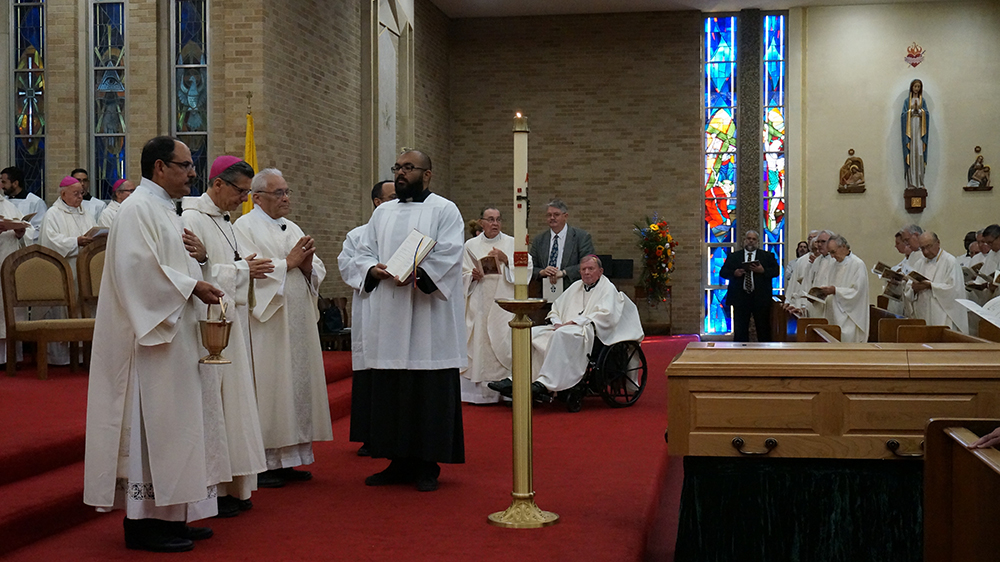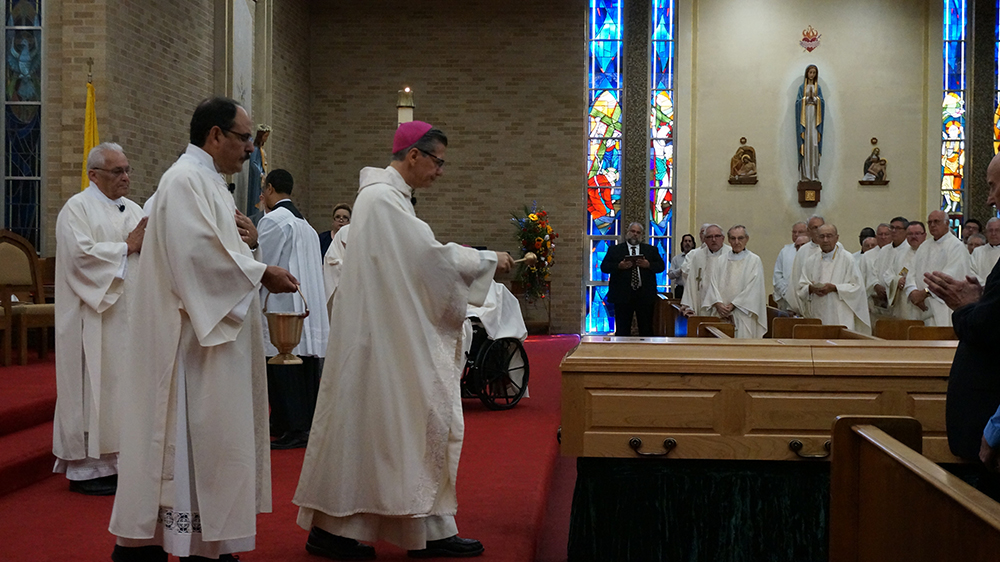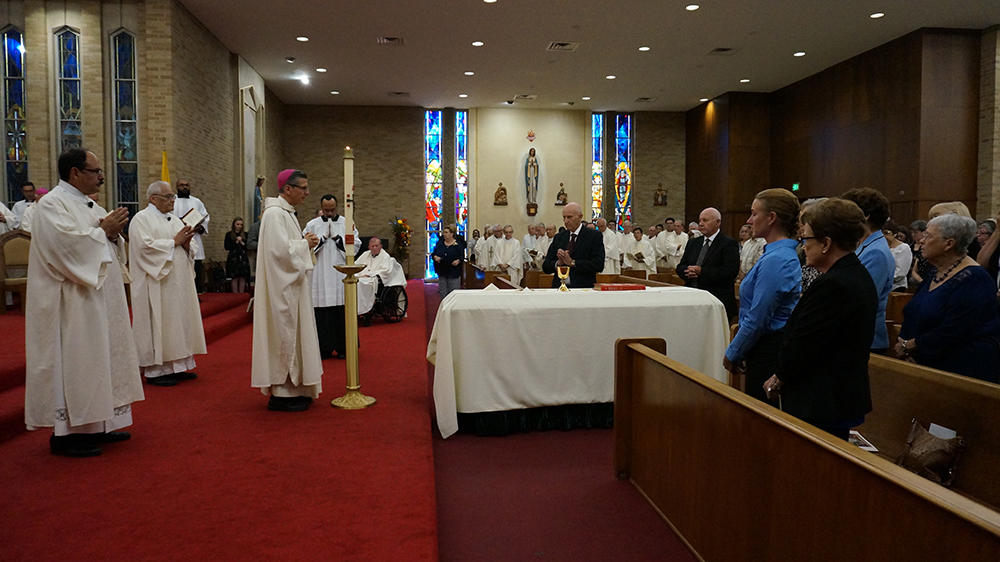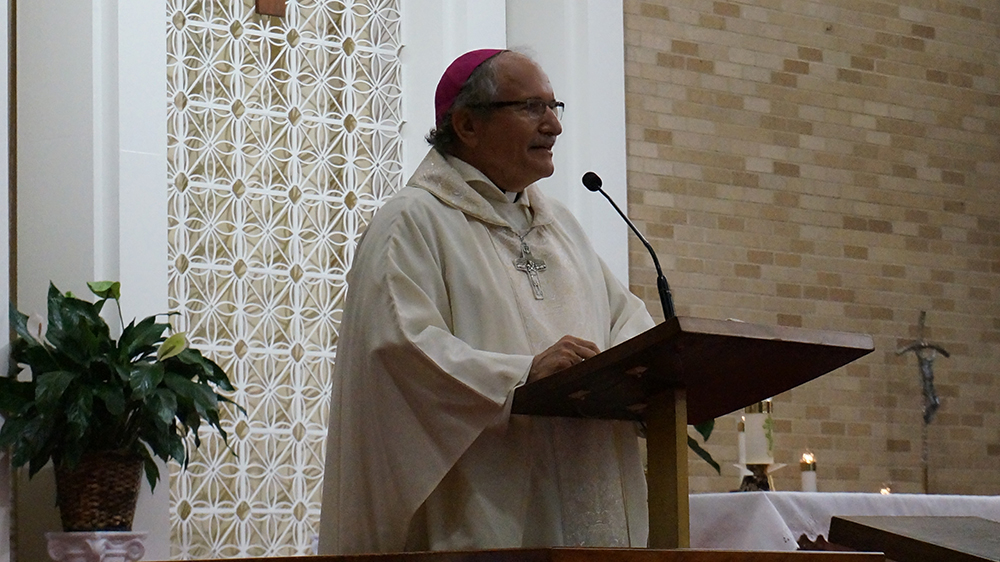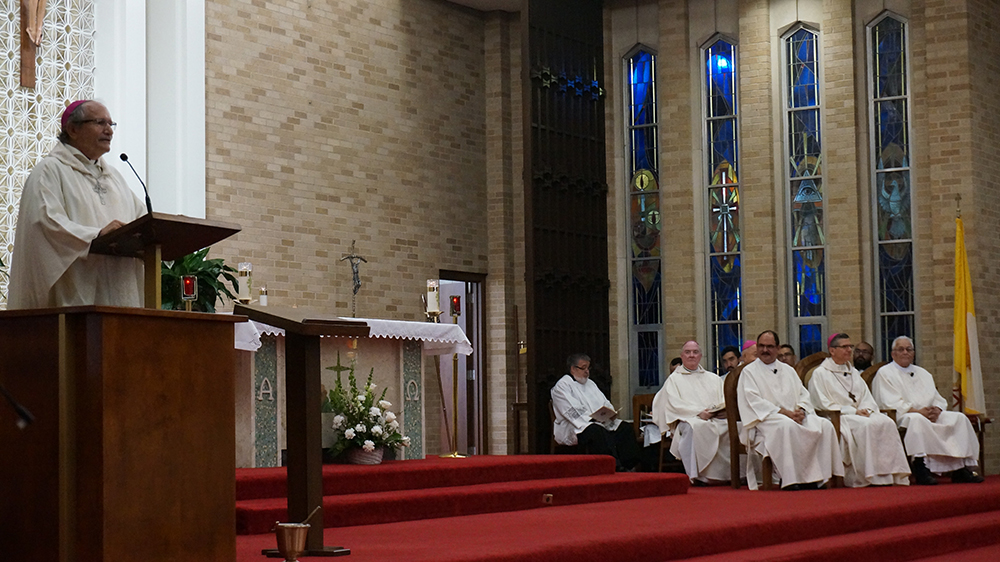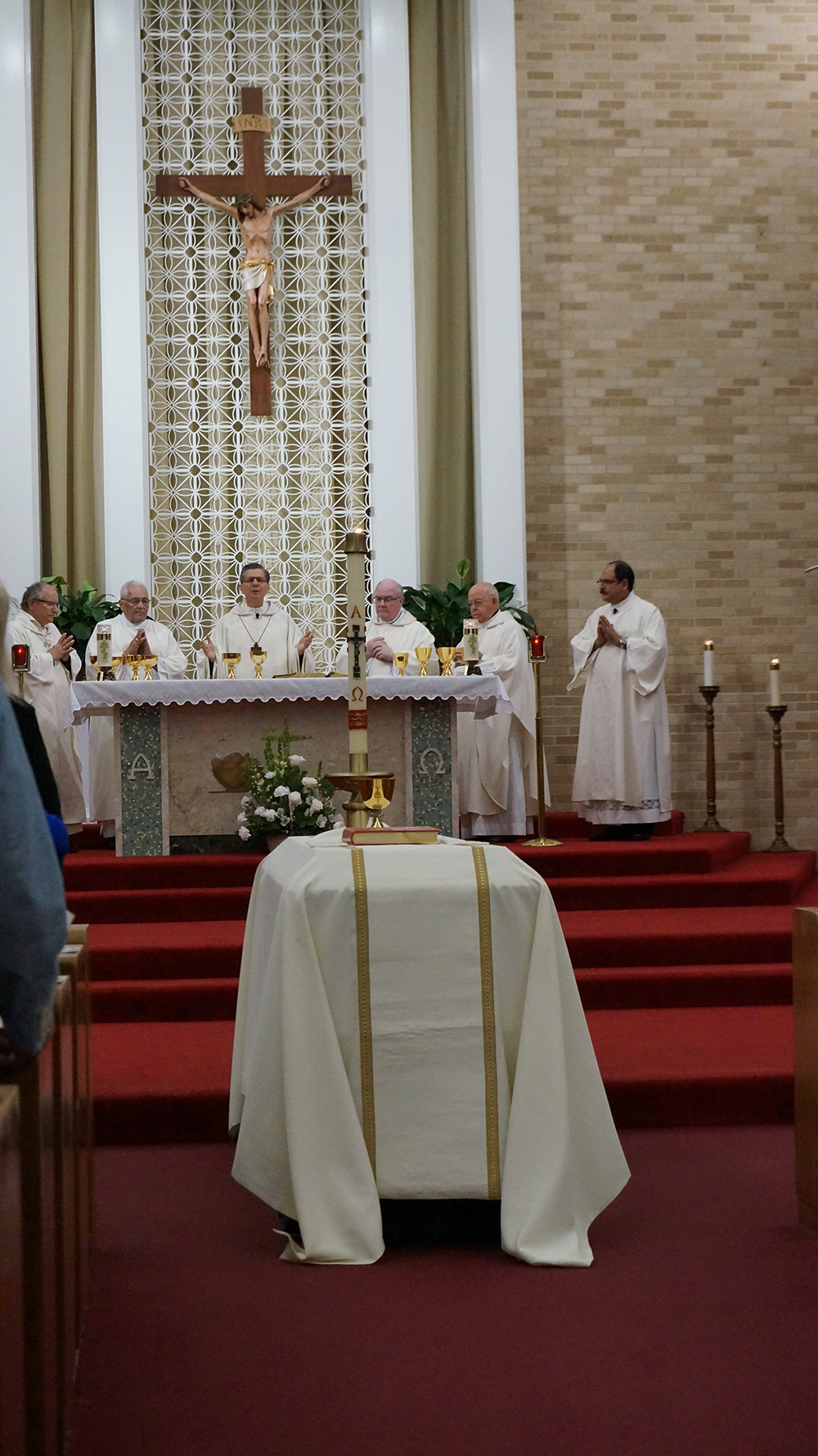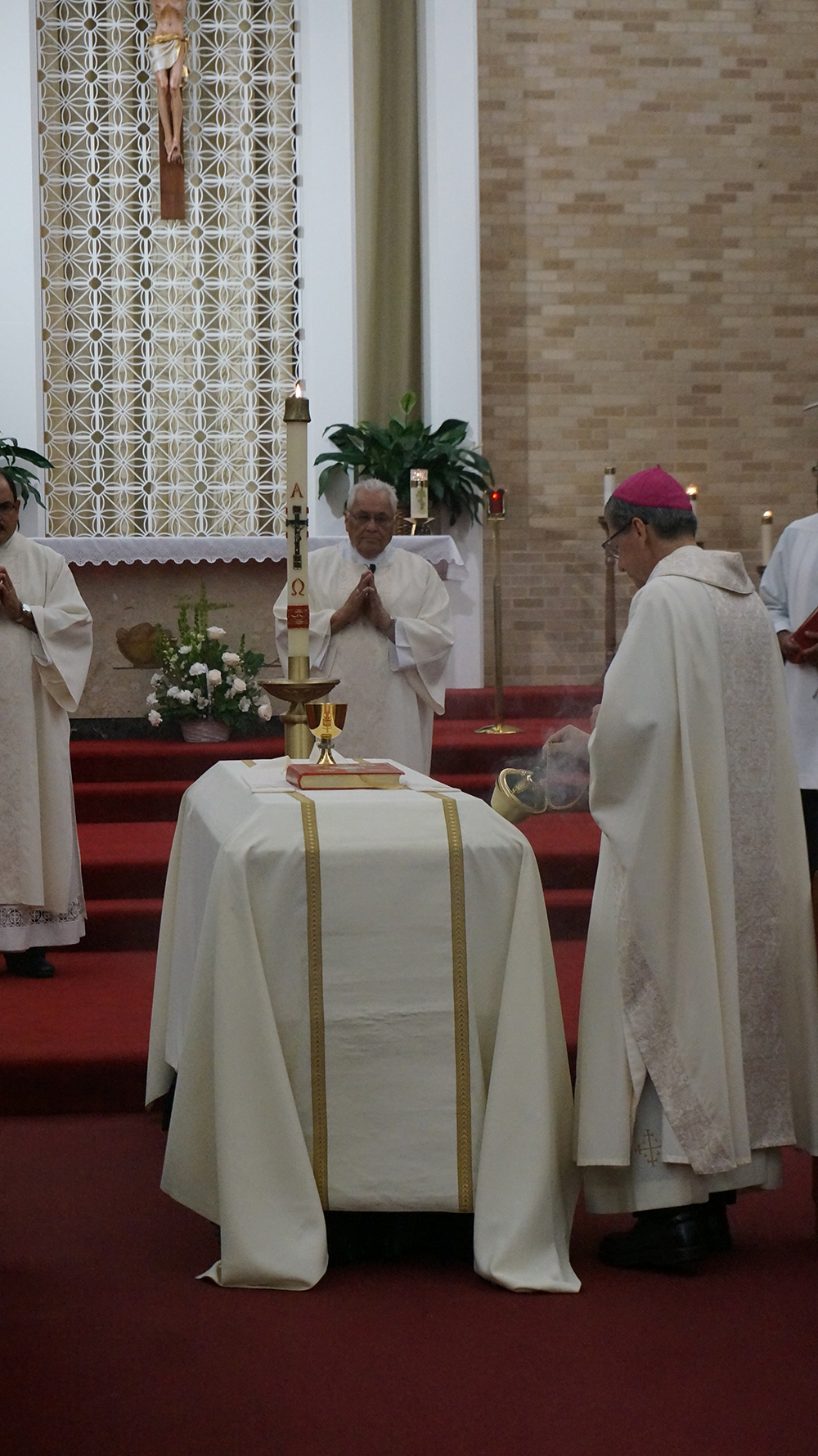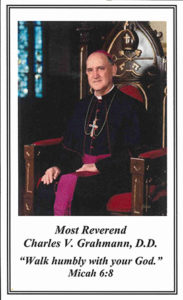Bishop Charles Grahmann concluded his life’s journey and arrived at the household of the Father on August 14, 2018. The Hallettsville native was a priest of the Archdiocese of San Antonio, an auxiliary bishop here, founding bishop of the Diocese of Victoria, and was later appointed the sixth shepherd of the Diocese of Dallas, the see from which he retired.
Bishop Grahmann died late afternoon at St. Luke’s Baptist Hospital in San Antonio. He had celebrated Mass earlier in the day at the Casa de Padres priest retirement residence and received the sacrament of anointing of the sick.
He was born on July 15, 1931, the fourth child in a family of 11 children in Hallettsville, a small rural community that lies halfway between San Antonio and Houston. His early life was spent on a farm.
Under the direction of his mother Annie Grafe Grahmann, Charles and his brothers and sisters did all of the work on the family farm while his father Nicholas Anthony Grahmann worked as a carpenter to supplement the farm income. The work was hard and the hours long as there were no mechanical implements, stated Charles. Everything was done by hand or with a horse or mule-driven implements, and there were chores every day.
He attended Sacred Heart School in Hallettsville from 1938 to 1945. He and all of his siblings attended a parochial school in spite of financial hardships; the family walked to church and school. When the vocation director of the Archdiocese of San Antonio visited Hallettsville and talked to the seventh-grade boys about priestly vocations, Charles discerned a call and left elementary school to enter St. John’s Seminary in San Antonio to study for the priesthood.
By 1946 the four oldest Grahmann children had all entered religious life or the seminary. His oldest brother, James Nicholas, had already entered the Christian Brothers and his sisters Alice Marie and Mildred both became Sisters of the Incarnate Word and Blessed Sacrament.
Charles had never been away from the Hallettsville area and the journey to San Antonio was a major milestone for him. His pastor drove Charles and two others to San Antonio. Friendships from his seminary days endured the rest of his life and into his retirement.
His studies at St. John’s took him through high school. In the summers he would return home to chop cotton in June and pick it in August. His philosophy and theology classes were taught at Assumption Seminary. In the summer of 1954, Charles and two other seminarians traveled to Germany, and he visited relatives there. It was the first of many trips he would make to Europe as a priest and bishop to visit relatives.
Archbishop Robert E. Lucey ordained him a priest on March 17, 1956 — St. Patrick’s Day — at San Fernando Cathedral. He celebrated his first Mass at Sacred Heart Church in Hallettsville on March 18, 1956.
His assignments took him to St. James Parish in San Antonio in 1956 and St. Joseph’s in Yoakum from 1956 to 1961. In addition to his priestly duties, he taught religion and Spanish in the parochial school, coached the basketball team, and started a high school football team.
His love for hunting and fishing nurtured as a boy continued all his life, and every year he and a group of priest friends from seminary days would go goose and duck hunting, playing Tarock, a European card game, in the evenings.
In 1961 Archbishop Lucey moved Father Grahmann to St. Paul’s Church. In August 1964, he was appointed priest-secretary to Archbishop Lucey. During this time he attended business college in order to monitor the business office and computerize the operation. Father Grahmann also attended Our Lady of the Lake University and obtained a master’s degree in Education and Counseling.
While serving as priest-secretary for the archbishop of San Antonio, he was appointed the archdiocesan director of Catholic Relief Services (CRS). After a trip to South America with CRS, his heart was moved greatly by the suffering of the poor people in that region. As a result, he pledged a lifetime commitment to caring for the poor which continued throughout his ministry.
After Archbishop Lucey’s retirement in 1969, he continued as secretary to Archbishop Francis Furey, with pastoral duties at St. Gregory the Great from 1970 to 1980. He was also named a monsignor during that time. While there he worked in the establishment of COPS (Communities Organized for Public Service), an organization created to empower people in the barrios of San Antonio.
Upon the death of Archbishop Furey, he was named vicar general to Archbishop Patrick Flores with pastoral duties at St. Joseph’s Church in downtown San Antonio.
In June 1981, he was appointed auxiliary bishop to the archbishop of San Antonio and ordained bishop on Aug. 20, 1981. He chose as his episcopal motto, “Walk Humbly with Your God” (Micah 6:8).
On May 29, 1982, he was named by Pope John Paul II as the first bishop of the newly created Diocese of Victoria, which had been created from the Archdiocese of San Antonio, the then-Diocese of Galveston-Houston, and the Diocese of Corpus Christi. He created a diocesan-wide consultation process to bring together clergy, religious, and lay people in a systematic way to put a face on the new diocese. After multiple gatherings reflecting on the nature of the church, the positive strengths of the people of the area and negative conditions confronting the people, issues, and goals were set forth and a plan of action was presented for this new diocese.
Then, on Dec. 11, 1989, he was appointed co-adjutor bishop of the Diocese of Dallas to Bishop Thomas Tschoepe. He was received in Dallas in February 1990 and became the ordinary of the Diocese of Dallas on July 15, 1990, the 100th anniversary of the establishment of that diocese by Pope Leo XIII.
Because of his special love for Hispanic people, he made ministry to them a primary goal. During the 1990’s about a million migrants, mostly Hispanic, came to Dallas in search of work. When the migration began in early 1992, he vigorously moved to welcome them and accommodate them. Masses in Spanish were promoted in every parish where sufficient numbers were present.
As the numbers increased during the 90’s, three parishes were established in predominately Hispanic population areas, Santa Clara of Assisi, Nuestra Senora del Pilar, and San Juan Diego, and the cathedral was renovated to receive some 12,000 Hispanics who attended Mass on weekends.
Priests were recruited from Latin American countries so that a Spanish-speaking priest was present in most parishes. The diaconate program in Spanish was established to train Hispanic men to serve in the parishes.
At the same time, parishes were established for other immigrant newcomers: Vietnamese (four parishes), Chinese; India (two parishes); also, Lebanese, Ukraine and Latin Rites.
As newcomers to Dallas came because of the many companies moving to the North Texas area, new parishes were established, along with John Paul II High School and new elementary schools.
He invited the Neocatechumenate Way to the diocese in the early 1990’s. Bishop Grahmann then invited them to bring one of their seminaries to the diocese, the Redemptoris Mater Missionary Seminary.
He also participated in the spirituality of the Focolare Movement, founded by Chiara Lubich in 1943 in Trent, Italy. The bishop first encountered the movement in San Antonio. Its hallmark is the promotion of unity by always living the simple command to love another as you love yourself. Because of its widespread appeal, it is highly ecumenical. He brought this to his ecumenical brothers in Dallas and formed a close-knit group with the ministers in other faith groups. Four of the ecumenical leaders attended yearly worldwide ecumenical meetings with Bishop Grahmann in Europe, giving all of them a new sense of their common journey toward unity. They engaged their churches in the three-year journey toward the third millennium, with yearly gatherings of the ecumenical leaders, clergy and lay, people, culminating in the festive gathering of all at the Meyerson Symphony Hall in January 2000.
He always believed that a bishop should be open to the needs of the whole church. Because of his experiences with the poor and the suffering of the world, he became involved in multiple projects worldwide. His yearly meeting with bishops and friends of the Focolare Movement gave him a deep sense of the needs of that worldwide church.
Early in his ministry, he teamed up with Bishop John Yanta to buy a bus for the seminary in Guatemala. They drove it from San Antonio to Guatemala City.
Already while pastor of St. Gregory, he initiated a “Walk for the Poor” by young people to raise funds for the Diocese of Juticalpa in Honduras. In Mexico, he provided funds for the Diocese of Oaxaca to buy sewing machines for groups of women who made clothing for the poor. He assisted the Diocese of Linares in building the pastoral center for the diocese. In the Diocese of Ciudad Victoria, he supported a special evangelization project.
In Brazil, he assisted the Diocese of Aracaju and Garenhius in renovating their seminaries and the Diocese of Recife in the construction of a new church.
In Syria, he provided funds to build a cheese factory in Aleppo for Christian and Muslim families.
In Lebanon, he provided funds to build an elementary school for 200 children who live in many nearby villages. He built a new church for the Melkite Rite near Sidon after the original church was destroyed by war. He provided a computer lab for a Catholic high school to serve the students and the community.
In the Philippines, he funded the purchase of a closed hospital with 35 beds. He provided transportation for a community of Poor Clare Sisters.
In Argentina, he provided transportation for Sisters, doctors, and social workers ministering in the mountain villages.
In Russia, he provided funds to purchase and renovate a seminary for the Archdiocese of Moscow after the fall of communism.
In Ukraine, he assisted parish renovations after the fall of communism in the Diocese of Lviv.
In the Czech Republic, he provided the Archdiocese of Prague funds to build a diocesan center, renamed after Mother Teresa.
In Ethiopia, he sent funds to assist the Daughters of Charity to feed 200 children each day and teach them in a remote area of the country. Also, he assisted a new bishop to get started there.
In South Sudan, he supported the only hospital in the war-torn country.
In the United States, he supported the Catholic Church Extension Society. He also assisted the Catholic Near East Welfare Association, which assists the poor and victims of war in the Middle East.
Before he was ordained a bishop in 1981, he attended a private retreat at a Benedictine Monastery. His spiritual director left him with a simple message for his episcopal ministry as a bishop: “Be poor. Be simple. Be humble. Point the way to Jesus for your people, and then walk humbly in their midst.” His motto became, Walk Humbly with Your God” (Micah 6:8).
He would say to young people: “Christ needs you in order to realize his plan of salvation! Have faith in Christ and he will not disappoint your wishes and plans but will fill them with meaning and joy. Open your hearts to Christ!”
In 2006 Bishop Grahmann marked the triple jubilee of his 75th birthday, the 50th anniversary of his ordination to the priesthood, and 25 years as a bishop. His biography, “To Walk Humbly with Your God,” was also published.
On his 75th birthday, he submitted his resignation to Pope Benedict XVI, and on May 1, 2007, he became bishop emeritus upon the appointment of a new bishop to Dallas.
In retirement, Bishop Grahmann remained busy until illness restricted his activities in recent years. In 2012 he moved to Casa de Padres, a retirement home for priests and bishops in San Antonio.
He is preceded in death by his parents and three sisters: Sister Anastasia, IWBS; Sister Sylvia, IWBS; and Rita Zaruba. He is survived by brothers Nicholas, Jr., Marcus, Jerome, Fred, and Brother Nicholas, FSC; as well as sisters Anita Spangler and Mary Ann Michalke. He has 25 nephews and nieces, grandnephews and nieces and two great-grand nephews.
Funeral services were held in Dallas, Hallettsville, and San Antonio. The funeral Mass in San Antonio was held Aug. 22 at St. Gregory the Great Church. Archbishop Gustavo García-Siller, MSpS, was the presider, and Auxiliary Bishop Michael Boulette, who knew Bishop Grahmann for 54 years, was the homilist.
